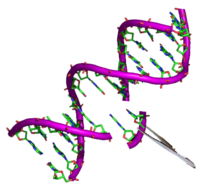
Photo from wikipedia
As the outermost hydrophobic layer, cuticular waxes serve as an essential waterproof barrier to protect plants from desiccation, but the mechanism of wax accumulation still remains unclear. We analyzed the… Click to show full abstract
As the outermost hydrophobic layer, cuticular waxes serve as an essential waterproof barrier to protect plants from desiccation, but the mechanism of wax accumulation still remains unclear. We analyzed the response of cuticular wax composition and deposition to drought in three different watermelon germplasms, namely, M20, M08, and J5F, which showed similar stomatal response, but high, moderate, and low tolerance to drought, respectively. Among the identified 28 compounds of cuticular waxes on leaves, more alkanes with chain lengths of C29 and C31 were induced in M20, accompanied by an increased transcript levels of CER1 ( very-long-chain aldehyde decarbonylase 1 ), when compared to that in M08 and J5F. M20 showed higher total wax amount but fewer platelet-like wax crystals on the upper epidermis of leaves under drought, suggesting the prevalence of more intracuticular waxes embedded into the cutin matrix as fillers. These distinct responses of cuticular waxes in M20 conferred low water loss and high tolerance to drought. Melatonin and abscisic acid (ABA), which can be induced by drought, promoted the biosynthesis of alkanes (C29 and C31) but inhibited the accumulation of wax crystals under drought. Moreover, melatonin inhibited the elevation of ABA levels under mild drought but promoted the ABA accumulation under severe drought, indicating that melatonin and ABA function synergistically to regulate wax compositions to limit non-stomatal water loss under severe but not mild drought in watermelon. These findings can be exploited to improve crop tolerance to drought in arid regions.
Journal Title: Journal of Plant Growth Regulation
Year Published: 2020
Link to full text (if available)
Share on Social Media: Sign Up to like & get
recommendations!